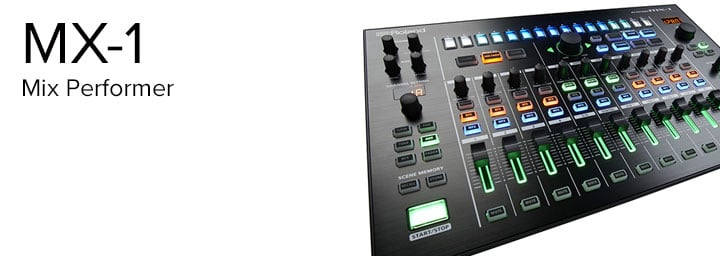Contributed by David Jiang for the Roland Australia Blog
Classic Roland Sound
The JP-8, JX-3P and Juno-106 synthesizers stand as stalwarts of their time. Released between 1981 and 1984, each produced classic synth lines to countless music genres. Many of the original synths have found their way into collector’s hands and in good condition are valued into the thousands of dollars. The JP-08, JX-03 and JU-06 Roland Boutique synthesizers take the powerful ACB technology from the hugely successful AIRA line and recreates these classic synths in a small modular footprint allowing studio owners, live performers and bedroom producers alike to experience the classic sound and programmability of the JP-8, JX-3P and Juno-106.
Small Synths Big Possiblities
While most functions of the Roland Boutique line are accessible with simple button presses, knob twists and fader pushes, beneath the hood there are some important extra features. A few quick button combinations unlock a huge variety of options. This Roland Boutique Hidden Features article will tell you about some extra features to get the most out of your synth

FEATURE #1 – Making the most of your step sequencer
FEATURE #2 – Portamento
FEATURE #3 – Layering and Split
FEATURE #4 – Chain Mode
FEATURE #5 – Velocity Sensitivity
FEATURE #6 – Master Tune
FEATURE #7 – MX-1 Compatibility
Feature #1: Making the most of your step sequencer
Each of the Boutique synths has an on-board 16 step sequencer with 16 pattern memories. While the Sequencer itself isn’t hidden, a few extra timing features really help to bring the sequencer to life.
Sequence Length
Any programmed sequence can have between 1 to 16 steps. You can change the sequence length in real time to create interesting patterns, verse/chorus structures or breakdowns.
Scale Length
Each step of the sequence plays at a 16th note interval according to the tempo by default. However, you can change the scale length to play each step at 32nd note intervals as well as triplet 16th and 8th notes.
Shuffle
By default the sequencer plays each note with perfectly straight timing (otherwise known as 50% shuffle). However, the boutique synths have 16 different shuffle settings to choose from giving you a more human feel to your patterns.
Step Order
Mix up your sequencer performance and change the step play order. By default the sequencer will play steps 1-16 repeating. However, you can select from seven different step order modes such as odd or even steps only, even then odd reversed or a fully random step order.
Off Step behaviour
Finally, you can change the way that the sequencer behaves when it encounters a step that you have turned off. You can choose for the sequencer to play a rest or to just skip over the step and proceed to the next on step.
All of these features when combined really allow you to turn an ordinary 16 step sequence into an exciting and varied performance.
Feature #2: Portamento
Portamento is a common feature of synthesizers, sliding from the last note played to the next. You can then change portamento timing using the right hand ribbon controller. The bottom of the ribbon controller gives you a faster slide between notes. As you go further up the ribbon controller, the synth will transition at a slower pace.
Feature #3: Layering and Split
Want to create a lush pad and four voices aren’t cutting it? If you have two or more Boutique synths you can layer each on top of each other by connecting each in a daisy chain via MIDI cables. As well as this, you can assign MIDI transmit and receive channels to each individual synth so if your MIDI controller has a split function, you can separate the synths across your keyboard.
Feature #4: Chain Mode
If you have two boutique synths and want to use them to achieve more than four voices you can put them into chain mode. Connect each synth via MIDI in a daisy chain. The first synth in the chain will then become the master synth playing the first four voices and any others down the chain will slave to that synth playing voices 5-8, 9-12 and so on.
If the chained synths are of the same type (two JU-06 for example) then the slave synths will follow any tonal changes made to the master synth (e.g. filter cutoff and resonance, oscillator type etc.)
Chain mode allows you to set up chains on different MIDI channels so you can split or layer multiple synth chains to create huge soundscapes!
Feature #5: Velocity sensitivity
If you are using the MKS-25 Mini Keyboard or a MIDI controller with a velocity sensitive keyboard you can take advantage of it! There are three velocity options on the boutique synths:
- velocity sensitivity on
- all key presses set to a velocity value of 64 (half velocity)
- all key presses set to a velocity value of 127 (full velocity)
Feature #6: Master Tune
Not everyone wants to work in standard tunings. A small change can make all the difference to the feeling of your performance. Luckily, you can adjust the Master tune of your synth between 433Hz to 448Hz.
Feature #7: MX-1 compatibility
Version 1.03* of the AIRA MX-1 introduced the ability for the MX-1 to communicate with certain non AIRA Roland products. The Boutique line is one of these products. The Boutique synths require bus power to run via USB so make sure you plug them into USB-3 on the MX-1. Once you are plugged in, the MX-1 can trigger and set tempo on the Boutique synths sequencer as well as apply Beat and Master FX.
* If your MX-1 is above version 1.03, you have this feature on your MX-1.
So there you have it, seven hidden features that will allow you to make the most out of your Boutique synthesizers.
Related Article
The Ultimate Guide to The AIRA MX-1




